You are reading the older HTML site
Positive Feedback ISSUE
january/february 2008
Impressions: The Walker Audio Proscenium
Black Diamond Tonearm, Upgraded Proscenium Pump, and Updated Reference Phono
Amp, a Photo Essay
by David W. Robinson
[All images and image processing by Robinson]
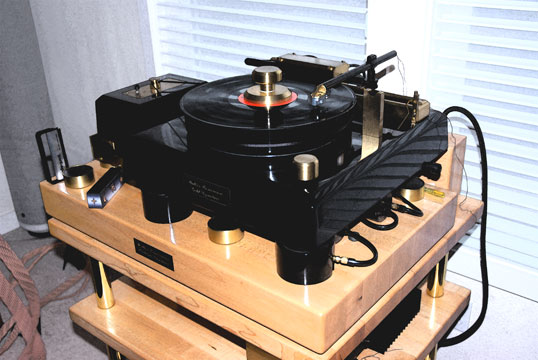
True glory! The Walker Audio Proscenium Black Diamond in fresco.
[Note to our readers: this photo essay was supposed to be finished months ago, but got hung up in a year in which health issues in the family raced professional challenges to outdistance the work. Sometimes deadlines win the race; more often than not, life wins. I've become a lot more philosophical as I've gotten older….]
Sometimes "exceptional" gets better…
PFO readers who have been following my turntable journey over the years are well aware of the fact that the arrival of the brilliant Walker Audio Proscenium Signature system hit me like a bomb. (For my reflections on my analogical leap, see PFO Issue 23, Jan/Feb 2006. I spent most of a year compiling my impressions, and then issued that very long evaluation. Then again, since my first comments on Walker Audio, all the way back in Issue 15, I have been consistently taken with the envelope-pushing excellence of the work that Lloyd Walker and Fred Law have produced. Whether they are introducing important new designs, or are tweaking another few percentage points out of what they've already done, Walker Audio always seems to find a way to make things better.
This time 'round is no exception.
In the fall of 2006, Lloyd Walker and Fred Law made another trip to PFO River City. This time they were going to install the new Black Diamond Tonearm, together with improved internal components for the Reference Phono Amp and the Proscenium Signature Turntable Air Pump. Lloyd told me that these upgrades would make a significant improvement in the quality of the playback (which was hard to believe, given the already stellar nature of the Proscenium Signature system). I've always found Lloyd to be truthful and accurate in his description of the changes he's made, so I waved Lloyd and Fred in. Bring it on!
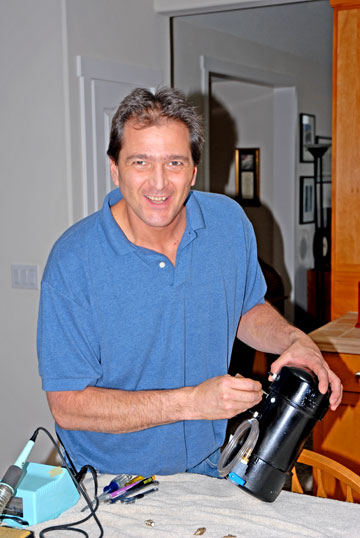
Fred Law of Walker Audio working on the air tanks during the Proscenium Black Diamond upgrade
The Proscenium has air suspension for its plinth, has an air bearing platter, and an air bearing linear tracking tonearm. This needs to be produced at a constant, reliable 45 PSI without pressure spikes or moisture build-up for the system to run properly—not a minor task. To supply the "big puff" for this system, Walker Audio designed and executed the most substantial turntable air pump system that I've seen. Here Fred is working on a tank assembly for the upgrade.

This is the Walker Audio Air Pump system before the upgrade, with the top removed. As you can see, the pump itself (in the compartment to the right) sends air to a series of separate chambers for pressure, moisture, and lubricant control. These go, in turn, to a coil under the chassis..
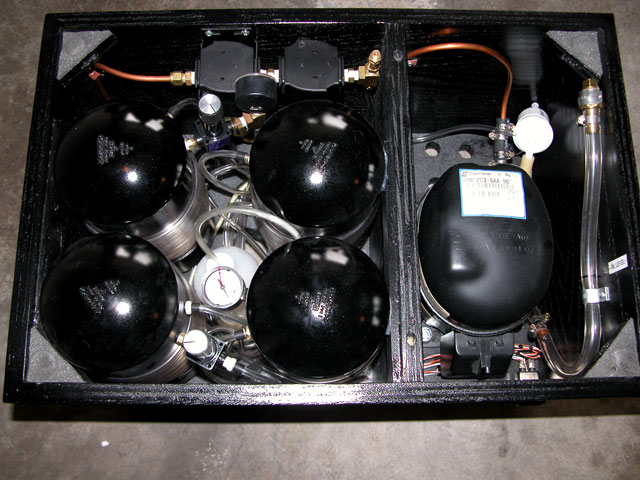
Here's a view of the Walker Audio Air Pump before the upgrade from directly overhead. It seems quite complex; in practice, it has performed quite reliably in my system since late 2004.
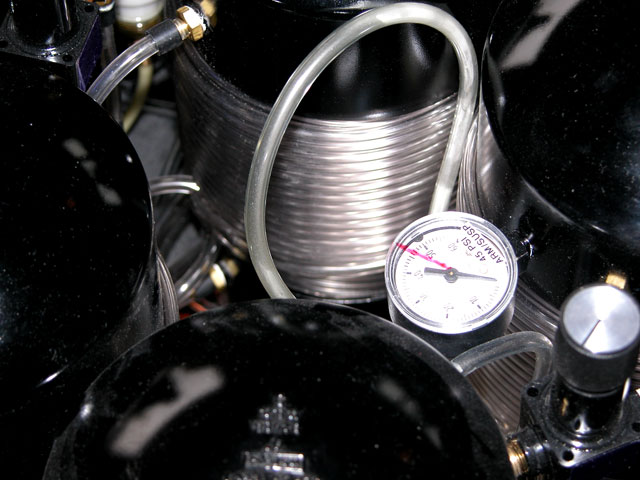
This is a close-up of the air pressure gauge in the air pump system before the upgrade; note that the proper pressure of 45 PSI is clearly marked. From the time I fire up the pump until the Proscenium Air Pump reaches operational pressure usually takes about ten minutes.

While Lloyd Walker prepares to upgrade components in the Walker Audio Reference Phono Amp, Jennifer Crock of JENA Labs keeps an eye on the proceedings.
While Lloyd and Fred were at work, JENA Labs' Jennifer Crock (also a Senior Technical/DIY Editor for PFO) dropped by to catch the proceedings and talk with Lloyd and Fred. Quite apart from her own world-class technical expertise, she's a very big fan of the Walker Audio Proscenium system. It was a real treat to listen to the two of them trade ideas back and forth and generally chew the audio fat.

Lloyd Walker in fresco: talking over the audio arts with Jennifer Crock
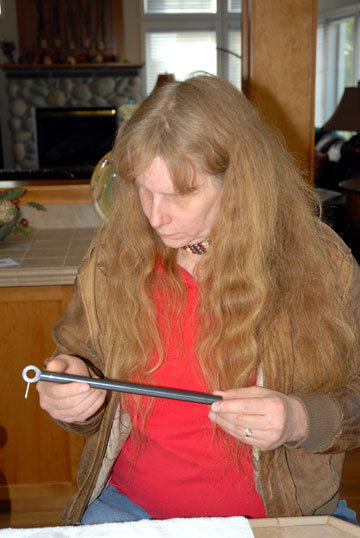
In which Jennifer Crock evaluates the new Black Diamond tonearm before it's installed.
Both Jennifer and I examined the new Black Diamond tonearm carefully. It was obviously different than the carbon fiber Signature tonearm that it replaced, with a smooth, hard finish, and a different resonance. Lloyd says that the Black Diamond is fabricated out of a very hard substance (he wouldn't say exactly what this was), "almost as hard as a diamond." Thus the name.
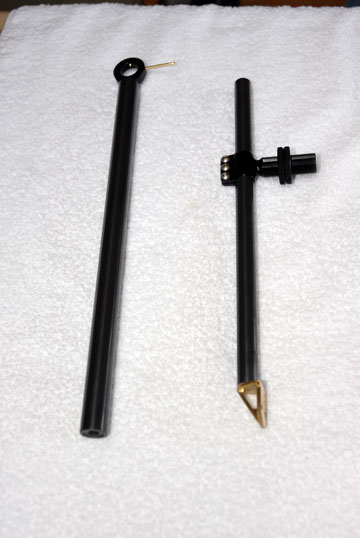
The new Walker Audio Black Diamond air bearing guide (left), and the Black Diamond Tonearm itself (right)
The configuration of the Black Diamond linear tracking arm and its air bearing guide look the same as the Signature components that it was replacing. Again, the only difference seemed to be in the composition of the components… that new Black Diamond material certainly had a different feel, a different heft in the hand.
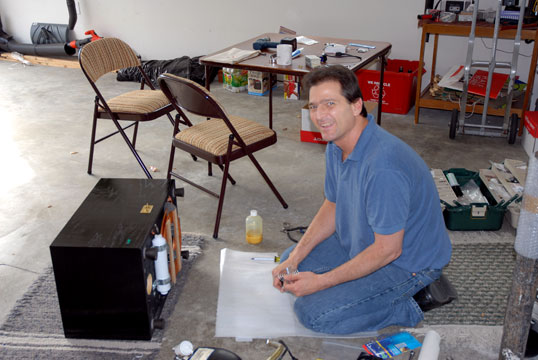
Fred Law prepares to upgrade the Walker Audio Air Pump by adding new components.
In this photograph you can see more clearly the size and relative dimensions of the Walker Audio Air Pump. Fred has it flipped up on its back side; you can just make out the green dot on the upside, which is the pump's power switch. When deployed, two clear plastic tubes attach to the copper-colored section in the middle of the upside, where two male tube connectors are located. Underneath, you can make out a white plastic chamber, and some coiled copper tubing to the right of that chamber.

This image shows the underside of the Walker Audio Proscenium Air Pump, immediately after Fred Law has cut out the hole for mounting the new fan system.
This shows the details I've described much more clearly. The sophistication of this air pump has to be seen to be fully appreciated. And yet, when I'm asked whether or not the Walker Audio Proscenium system has ever been a problem, I'm able to say "Not one problem in three years—and counting." And the maintenance on the system is ridiculously easy to do …a few minutes per year.

A rare look at the inside of the Proscenium Air Pump chassis from the top side, partly disassembled, before the new fan system is installed.
I assume that the new fan was installed directly under the pump to control the heat. The Air Pump system could get warm if you used your turntable for very long stretches…it runs cooler since the upgrade.

The new custom Walker Audio RCA jacks for the upgrade of the Walker Audio Reference Phono Amp.
One of the upgrades that Lloyd installed on his Reference Phono Amp was new RCA jack assemblies. These improved the signal path and dispensed with the use of solder. Very cool.
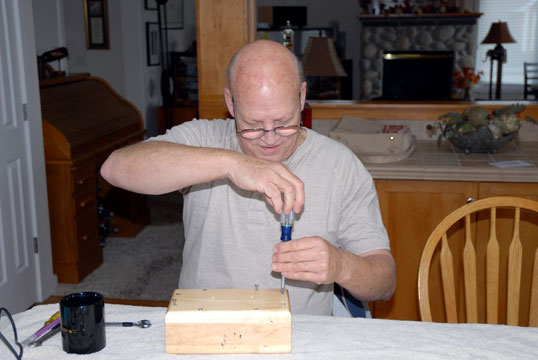
Maestro Lloyd opening the Reference Phono Amp for the upgrade surgery—say "AAAH!"
Walker's Reference Phono Amp is probably the most understated component in the whole system. I've had listeners overlook it completely when they're looking at the turntable …they have trouble finding the phono amp! As it happens, that maple chassis above is the phono amp. No knobs. No LEDs. No flashy metal.
Just a maple box.
Not!
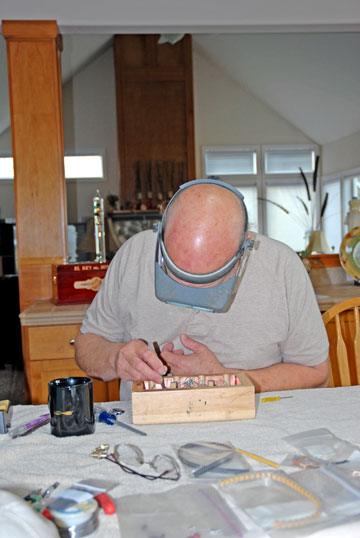
In which the good doctor Lloyd goes to work on the incredible point-to-point wiring inside his Reference Phono Amp.
The solid state components within the Reference Phono Amp are all personally selected by Walker Audio, and each is custom tweaked for maximum performance. Then each is meticulously hand-soldered into place with the shortest possible leads in point-to-point fashion. I've watched Lloyd at work several times; his attention to detail and craftsmanship are truly exceptional. Even Jennifer Crock was impressed—and Jennifer does not impress easily.

Fred reassembling the Proscenium Air Pump, re-positioning the pump over the new fan assembly
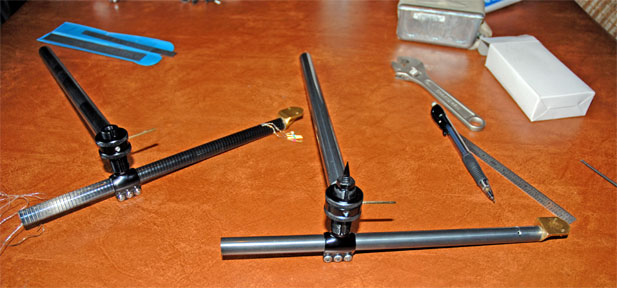
Out with the old, in with the new…
You can see the visual differences between the old Proscenium air bearing guide and tonearm on the left, and the new Black Diamond air bearing guide and tonearm on the right. (To have the both of them before you is a rare sight in itself.) You can see the ripples on the surface of the older carbon fiber Proscenium tonearm, while the ultra-rigid Black Diamond tonearm is a smooth, seductive dark gray. The sonic differences are just as obvious, believe me.

Fred Law in the midst of mounting the Micromagic Magic Diamond on the Proscenium Black Diamond tonearm
Fred Law does a lot of the work on mounting and dialing in the cartridges on the Proscenium tonearms. Doing work like this is a skill all its own, and many folks don't have much experience with getting a phono cartridge just right. I've seen some cartridge sessions in my time, but nothing to beat Fred and Lloyd when they're on the hunt for just the right VTA, azimuth, tracking force, and damping. Bloody amazing.
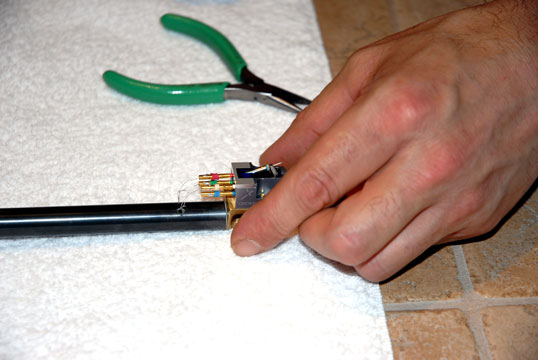
A close-up view of the Walker Audio Silver Pickup wires being fed through their access hole into the segmented chambers within the Black Diamond tonearm. To enhance RFI rejection (a major problem up here in my listening room on the hill), a twisted pair construction was used to accomplish this task.
There are a number of pleasant aspects to living high on a hill, but one of them is not dealing with the RFI that goes with all that view in a modern urban setting. I've had to take some special measures in both my home theater room (Jensen isolation transformer for my Linn Melodik subwoofer …otherwise awful RFI) and listening room (shielded cables for extended cable runs from the non-Proscenium sources, and twisted pair with the Walker Audio MC cables). Lloyd and Fred found my room to be a serious challenge, but, to their credit, persevered until they found a grounding configuration that worked well. Good men!
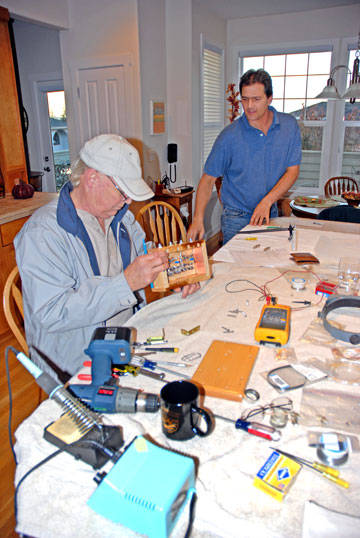
Fred watches while Lloyd installs the new custom RCA jacks on the Reference Phono Amp
The upgrades to the phono amp took quite a while to install. Was it going to be worth it? "Wait until you hear it," sez Lloyd. And, you know, I've found that Lloyd is right about these things.
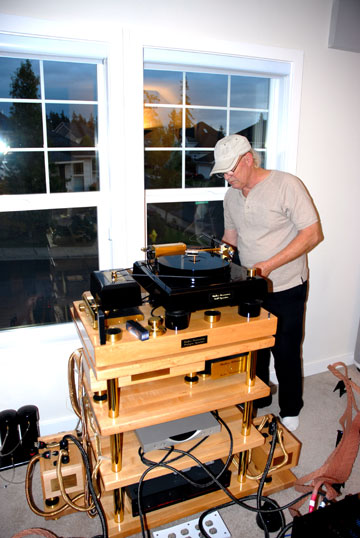
Having completed the various upgrades, Lloyd begins the process of dialing in the new Black Diamond tonearm
Even after getting all the upgrades done to the Reference Phono Amp, the Air Pump system, and to the Proscenium turntable—not to mention the cartridge noodling—there's still the business of getting all the components to sing together. Lloyd has a definite procedure for this…
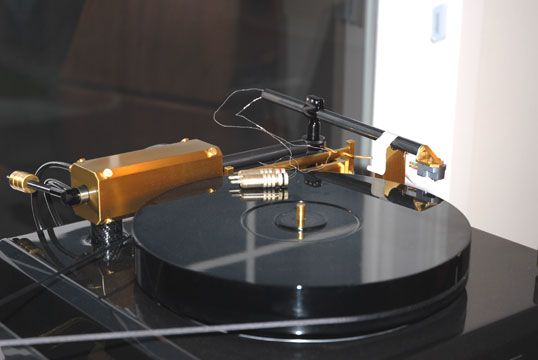
The Black Diamond tonearm mounting and adjustment of the Magic Diamond MC is completed—the next step is to get the upgraded Walker Audio Reference Phono Amp installed just behind the back of the Black Diamond. Note how short the silver phono leads are …as it should be.
…which involves the use of a dedicated digital multi-meter (DMM). It allows him to precisely null any outside interference using the small adjustment pots on the Reference Phono Amp by making adjustments until he hits "0.00" on the DMM. No guesswork here. (There are also no lights, LEDs, knobs, or switches on the Walker Audio Reference Phono Amp; this is a truly minimalistic approach to audio purism.)
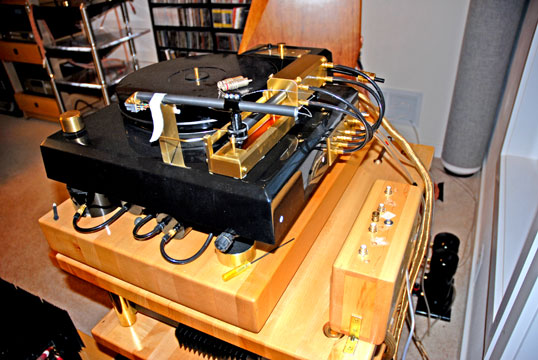
A rear view of the Black Diamond Proscenium, showing the upgraded Reference Phono Amp mounted in place. The sophisticated set of air tubes and chambers are clearly seen, as is the near-ideal relationship of the tonearm to the phono amp. On the floor you see the pair of black air pressure chambers, acting as a pressure/moisture trap for the system.
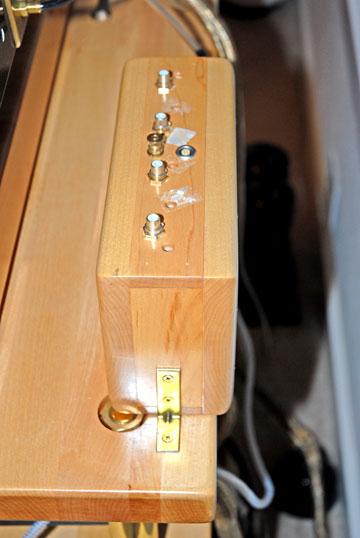
A close-up view of the solid maple chassis of the Walker Audio Reference Phono Amp—it looks very simple, but its sound is simply killer!
"Gain without pain" is the holy grail of phono amplification—amplification, and nothing else—would the upgraded device be better?
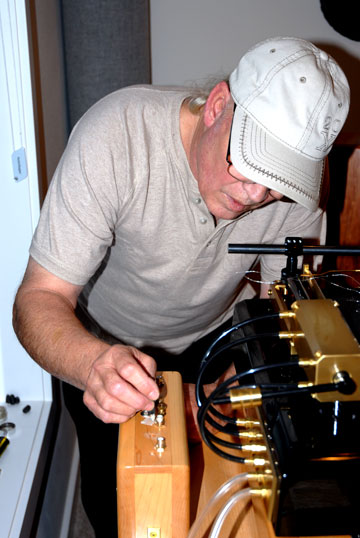
The Lloydmeister at work. One thing you learn about Lloyd Walker when he's on the hunt, dialing in one of his turntables: don't bug him!
At first, Lloyd had a great deal of trouble with the RFI problem. The upgraded Reference Phono Amp was definitely more sensitive to the problem than the earlier revision had been. Lloyd attributed this to the improved components that we had seen him add. Since I had witnessed both dial-in sessions—this one taking a lot more time for the DMM to null—it would appear that the upgraded unit was a good deal more susceptible to interference in an exposed setting like mine.
The good news is that the unit did finally null …with some help from a friendly grounding cable.
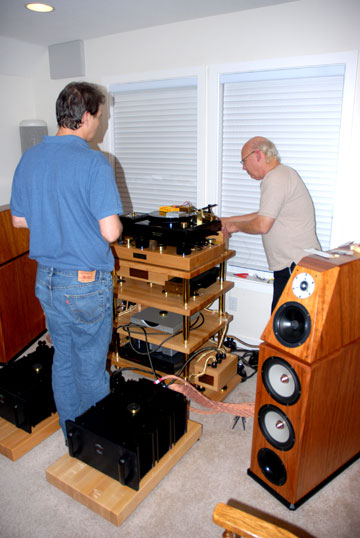
Fred and Lloyd complete their final adjustments to the Reference Phono Amp.

The Black Diamond Tonearm and guide in its new home; you can just make out the new copper grounding cable in the lower right corner of this image.
So, a year later, how would I sum up the upgraded Walker Audio Proscenium Black Diamond system?
First of all, the upgraded air pump has functioned without a problem. From what I saw, the main idea here was to increase the air circulation to the main pump, to reduce heat build-up within the pump unit. It certainly seems to have done that …the pump, which runs warm, now pushes that air out into the media storage area where it resides. The air pump is cooler; the ambient air in that space, warmer. I have run turntable listening sessions that run many hours at a stretch, without a hiccup. Overall, this one is a plus for reliability.
The combination of the upgraded Reference Phono Amp and the Black Diamond tonearm is a different critter altogether, though. The new components that Lloyd installed very definitely increased the transparency of the unit, taking another step along the magical way of the Cheshire Cat: the road to vanishing completing.

I've made this point more than once over the past few years. The most important thing that audio gear can do is to get out of the way of the recording. Increasingly, I've come to believe that transparency…this "removal of veils"…is the foundation of all other audio virtues. The main thing we want from fine audio gear is amplification and volume control, without various overlays, and without the signal path editorializing the process. It sounds simple, but in practice it's hard to do. Most audio components really do have some sort of flavor that they impart to the signal passing through; most audiophiles compensate for this by either baptizing the component, rationalizing the result, or by deforming the rest of their audio system into a giant, awkward tone control. If that's what we want, then an equalizer is a far more elegant and intelligent solution, no?
What I find with the Walker Audio Reference Phono Amp is nothing like that. This phono amp, with its complete absence of knobs, switches, controls, lights, and LEDs, sitting compact and quiet in its solid maple chassis, is simply waiting for you to cue up your next LP, so that it can vanish once more. More than I've ever heard with LP playback, I get gain without feeling that the music came through something.
It just is.
The Reference Phono Amp allows the smallest nuances that I've ever heard in my grooves come through, while handling sudden major swings in dynamic passages without congesting or becoming harsh. Clarity in spades, rich musicality, tonal rightness, and detail without sounding like a forensic pathologist just stepped in the door…it's the complete package. There was no sense of tonal darkening or roll-off that I've noticed with some turntables over the years, a feeling as if your head has just been slightly withdrawn from a listening venue as soon as the stylus hits the groove. Spaciousness remains. Violin strings on the best recordings shimmer and sound like gut, not like steel. Kettle drums are round, and slam! Cellos resonate richly, growling in their woodiness; trumpets pierce you with wind and metal and spit. It's all so bloody right. I've proven again and again to my complete satisfaction: any RCA Living Stereo, any Decca, any Mercury—the label's "family sound" doesn't matter—was revealed down to the groove walls with the new Proscenium system. (Footnote here: "system" here includes the Walker Audio Prelude Record Cleaning package as well. With a vinyl playback team that is this revealing, make sure that your LP is ready for action. If this sounds hyperbolic…well, let's just say that you've been told.)
How much of this is the phono amp, and how much the Black Diamond tonearm? I couldn't say, and I couldn't say that I care. I suspect that the Black Diamond tonearm with its more rigid structure is digging out more detail with greater accuracy, and imparting a quickness, an improved responsiveness, to the sound. And this newer Reference Phono Amp is delivering this enhanced signal with a nearly supernatural ease …but this is not the sort of thing that would be easy to do an A/B comparison of. Let's just say that if I was upgrading the one, I would certainly upgrade the other. Or if I was looking to purchase, I would not stop with the Proscenium carbon fiber arm…which I have loved and respected for years now…but would bite the larger apple for the Black Diamond. You might as well be hung for a sheep as for a lamb, eh?
Remember the caveat that I mentioned, though: the new Reference Phono Amp is sensitive to RFI. This is the price that you pay for the unique crystalline performance of this device. I can assure you that even extremely nasty RFI can be brought under control and nulled. Lloyd and Fred did a terrific job taming the lions here; they can certainly do it where you are should you be in a very active area for RF, as I am.
I have to admit it: the Black Diamond/Reference Phono Amp was the last straw.
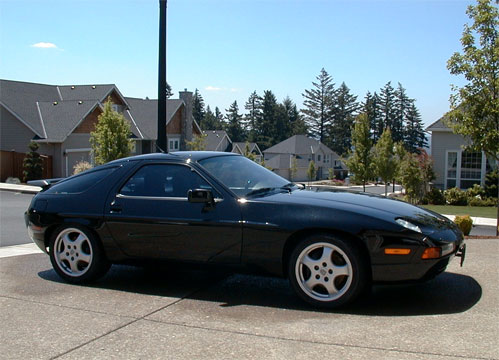
So …how good is the Walker Proscenium Black Diamond turntable system? Well, good enough to turn my delightful 1990 Porsche 928GT…
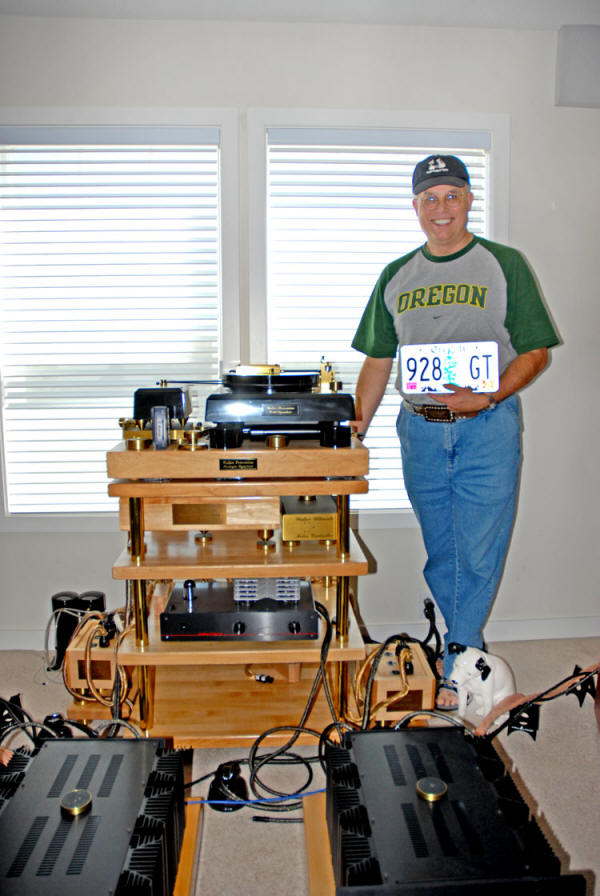
…into a pleasant memory. I truly loved my 928, but I just couldn't do without the Proscenium Black Diamond—and the money to make the purchase had to come from somewhere, eh?
Well, Portland, Oregon, doesn't have many Porsche driving days, but I figure you can always put on another LP. Sometimes you have to make painful choices, and put your money where your mouth is …this was one of those times. (My Porsche friends thought I was crazy; my audiobuds thought I was inspired.)
For the record, that's how good I think the Walker Audio Proscenium Black Diamond system is. Next time you're wondering about what ultimate turntable to purchase, remember to check out the smilin' gent in the photograph above just one more time….
